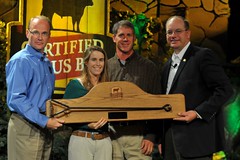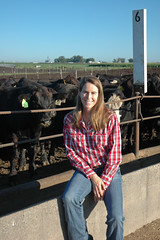Cozad, Nebraska is rumored to be the “alfalfa capitol of the world”. Our school mascot is “the Haymakers”. As our name demonstrates, we are a rural farming community.
My husband is a Haymaker through and through. Not only did he play football on this field and set records on this track, but he is a “professional haymaker” on our farm.

Matt’s school record in the 200 meters held for 21 years until a new dynamo runner broke it last year…
So, outside of being Cozad’s team mascot, what exactly is a Haymaker?
In farming language, hay can mean many things…In my husband’s vocabulary, hay means alfalfa and a haymaker is an alfalfa farmer. Alfalfa is a perennial legume plant that can be harvested for 5-8 years after planting. It is a high protein forage (17-19%), and has an excellent amino acid profile. In other words, alfalfa provides the essential amino acids that animals require, but can not synthesize on their own. It also has a high level of soluble fiber which is important for animal digestive health.
Because it is a legume, alfalfa takes the nitrogen out of the air and makes it available to the plant so that no nitrogen fertilizer is necessary for its growth. When the alfalfa dies, it also leaves residual nitrogen in the soil which helps to fertilize the next crop. My husband starts harvesting mature alfalfa about the 1st of May and hopes to get four cuttings (harvests) of the plant during the growing season which ends in October.

This is a swather–which is the machine that cuts the alfalfa. It is like a big lawn mower and places the cut alfalfa in windrows (strips) down the field.

After the cut alfalfa has laid in rows on the field for several days (which allows the sun to dry it), the chopper picks up the alfalfa, cuts it into small pieces, and deposits it into a truck.

The trucks transport the cut up alfalfa from the field to the alfalfa dehydration plant where it is further dried and compressed into animal feed pellets.
While I feed some of Matt’s alfalfa (in the form of big bales instead of pellets) at the feed yard, much of what he grows and dehydrates is shipped to feed animals all over the world. From cattle to chickens to horses to gerbils to zoo animals—alfalfa is a great animal feed. My haymaker has traded his football and track shoes for work boots, and has become a true alfalfa farmer…
My haymaker has traded his football and track shoes for work boots, and has become a true alfalfa farmer…
Our girls are loyal Cozad Haymakers and have their eyes locked on one day holding their own track records—Matt and I hope that one of them will also set their sights on transitioning from a Cozad Haymaker to an alfalfa farmer to continue our family tradition…
















Love this!
Feed Yard Foodie would never headed to Nebraska if it wasn’t for her Haymaker! I am glad that you enjoyed it–thanks for stopping by and commenting.
Anne
Awesome blog! Keep educating the public about what it takes to be involved in production agriculture so they know how safe our food supply really is!
Hi Andy,
Thanks so much for your compliment. I appreciate your support and you taking a moment to read my blog posts. I hope that you will keep following and also help to spread the story of “where your food comes from”.
All the best,
Anne